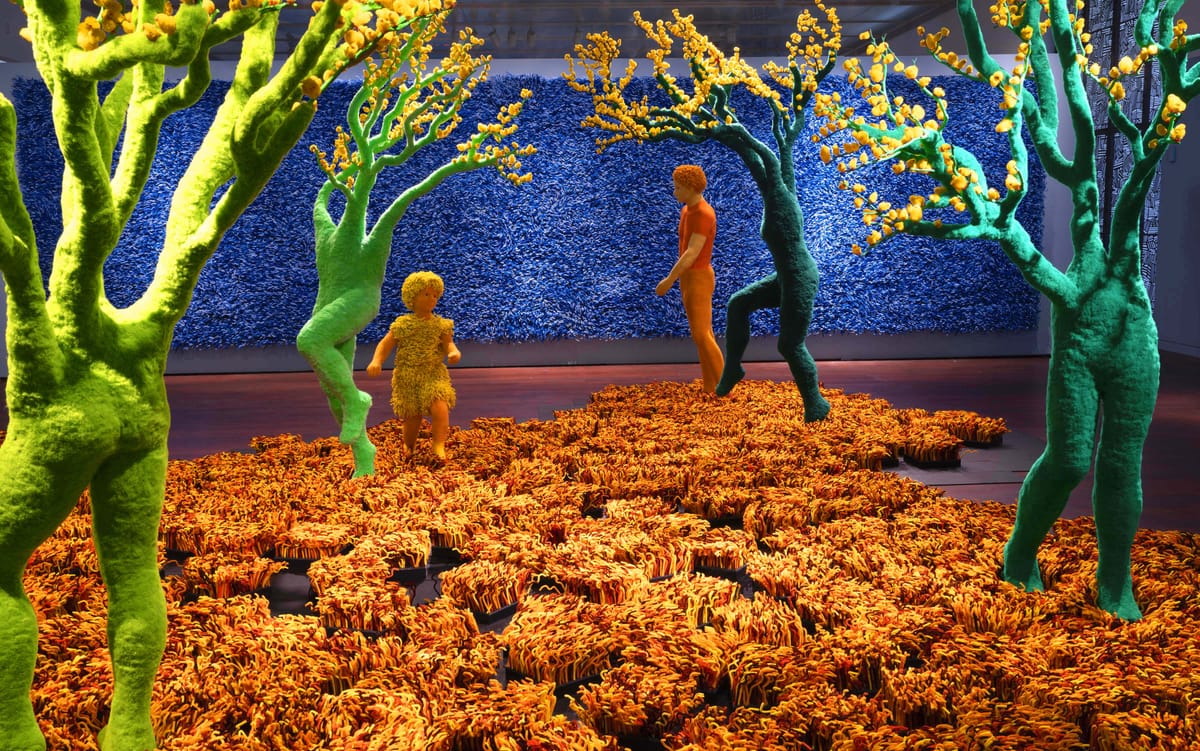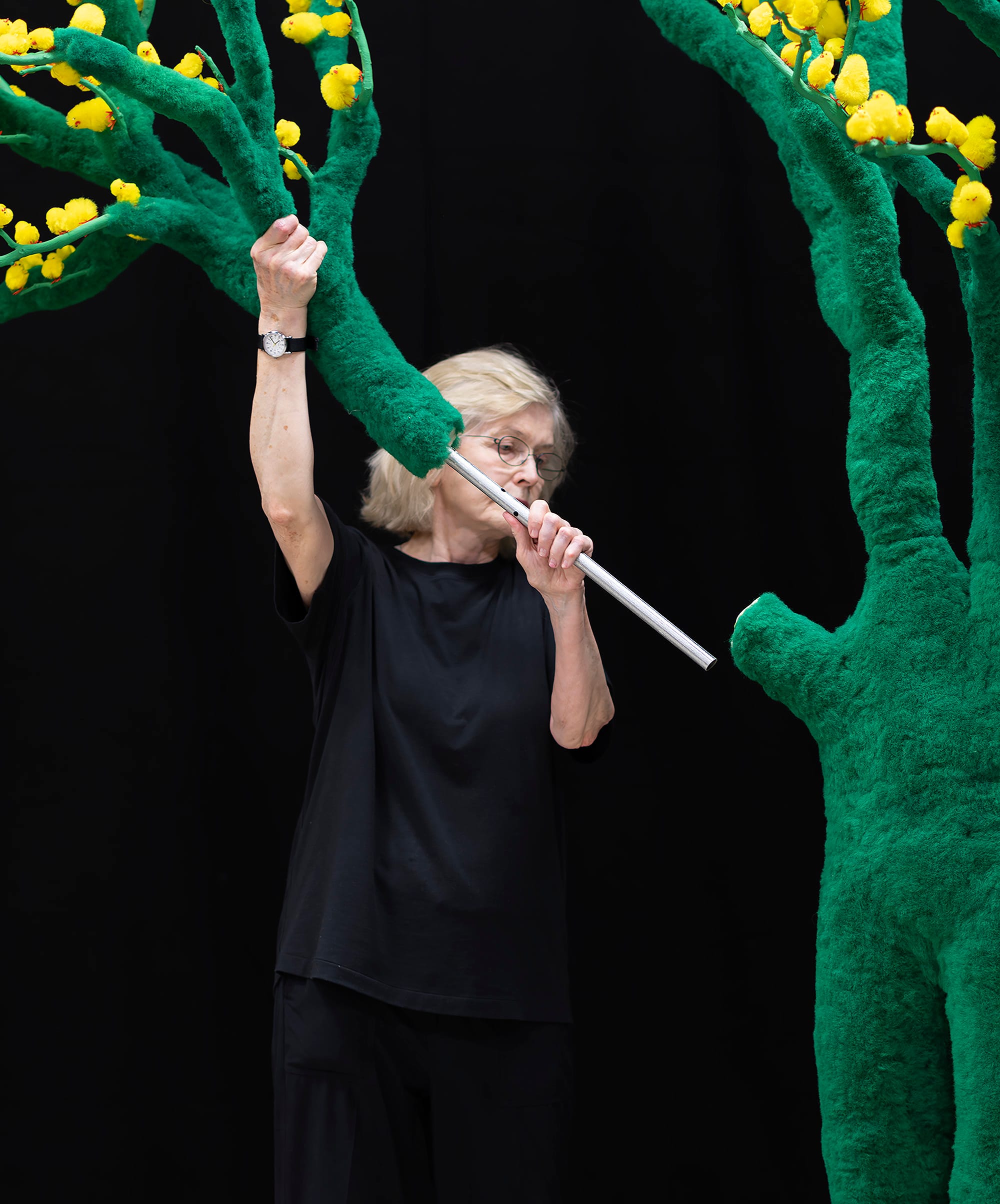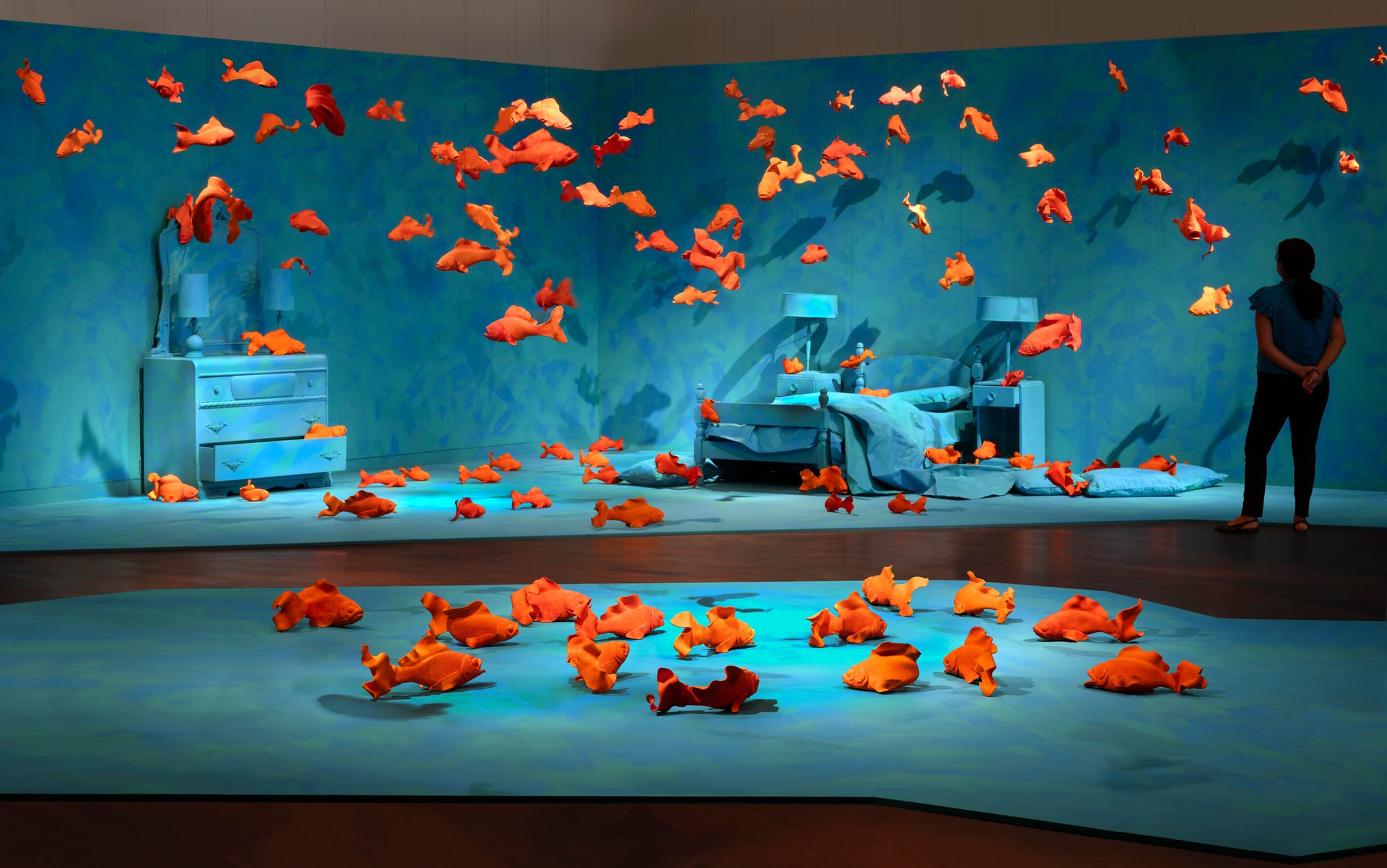
Sandy Skoglund, who helped trail-blaze surrealistic staged environment photography in the 1980s and 1990s, has debuted an immersive work based on one of her photographs in a solo show at the McNay Art Museum in San Antonio.
The exhibit “Sandy Skoglund: Enchanting Nature” runs through Feb. 1, 2026, and thematically tackles the resilience of nature and its clashes with the human-built world.
The never-before-exhibited work, Fresh Hybrid, is an installation version of her 2008 photograph that depicts a human family and their dog walking through a forest-like environment in which the trees have humanoid legs and also appearing to be walking. On the forest floor is fallen foliage, made from colorful pipe cleaners.
It is one of three such installations in the show. The other two are Radioactive Cats (1980) and Revenge of the Goldfish (1981), which are considered two of the most influential images of the staged photography movement and were included in the 1981 Whitney Biennial. Both of those early installations have been publicly exhibited at various venues.

“Their juxtaposition in the galleries reveals some elements associated with the evolution of Skoglund’s art over time. Both Cats and Goldfish incorporate a two-color palette: Cats being green and gray, Goldfish being orange and blue,” McNay head of curatorial affairs René Paul Barilleaux told Urgent Matter in an emailed interview.
“Fresh Hybrid, however, has an expanded palette, evident in the three ‘human’ figures, dancing trees, carpet-like floor covering and rich blue sky/wall. Also, Hybrid is not wall-bound in the way that both Cats and Goldfish are. Hybrid is viewable from all sides, and its composition is less rigid than other of Skoglund’s installations.”
In previous stagings of the Radioactive Cats and Revenge of the Goldfish installations, viewers were previously not able to walk among the art because of their wall-bound nature. In their presentation at the McNay, Skoglund has configured them in a new way, providing a pathway through each that allows viewers to actually be immersed in the artwork.
“Thinking about the age of selfies and social media posts, the artist wanted to provide a way that viewers can capture themselves—their families, their friends—within a Sandy Skoglund artwork,” Barilleaux said.

In the new show, Skoglund also explores the use of wallpaper for the first time, allowing her defining photographs to be seen at a monumental scale.
Barilleaux, who organized the show in collaboration with the artist, celebrated how the wallpaper allows viewers to see fine details in her photographs that are often missed.
“Among the most notable details seen in the monumental wallpaper enlargements—and one of my favorites—are details visible in the wallpaper installation of Revenge of the Goldfish,” Barilleaux told Urgent Matter.
Barilleaux noted that the show would include both the original sculptural installation as well as a wallpaper enlargement of the photograph. This enlargement is featured on the main wall of the McNay’s entrance lobby, greeting visitors as they arrive.
When viewers see the installation, they see ceramic goldfish that appear to float in space. In the original 1981 photograph, the goldfish also appear to be magically floating.
“However, in the wallpaper enlargement, one can clearly see the thin monofilament cords coming from the ceiling and holding each fish in mid-air,” Barilleaux said.
“It is these seemingly ordinary elements—ceramic fish suspended by thin filament—that reveal how Skoglund constructs her sculptural tableau and reenforces the fact that everything visible in a Sandy Skoglund photograph is an actual three-dimensional object.”
Wallpaper and environmental design are having a resurgence in museum shows, often tied to the broader idea of immersion. The McNay is one such museum that has embraced incorporating wallpaper for its exhibits in the past. But Skoglund had never worked with wallpaper until Barilleaux brought up the idea to her while planning the exhibit.
“Skoglund was intrigued and—after discussion about which photographs, what scale and where they would go—she carefully selected parts of each image and sized them to fit corresponding spaces,” Barilleaux said. “She saw the wallpaper installations only after they were completely installed on the gallery’s walls.”
The McNay noted that one wallpaper installation, Revenge of the Goldfish, will remain in the McNay’s AT&T Lobby through 2026, even after the end of the show. Barilleaux said this is because the museum will also include Skoglund’s installation The Cocktail Party in its spring/summer 2026 exhibition, “untitled: 20 Years of Collecting Contemporary Art.”
“Since Skoglund’s artwork has a presence in the galleries for a year, it made sense to extend her presence to the lobby for a year as well,” Barilleaux said.
Speaking on Skoglund’s legacy, Barilleaux noted that both Radioactive Cats and Revenge of the Goldfish appeared at a time when artists, including artists working with photographic imagery, began to question what kind of images were made and how they were made. That theme is particularly relevant today in the age of artificial intelligence.
“Today, when anyone can create a digital image on their phone or produce one through AI, it's even more pressing that viewers understand that Skoglund makes sculptural installations in three-dimensional space using actual materials,” Barilleaux said. “So then, everything in a Skoglund photograph is true.”
Correction 2:34 p.m. October 24,2025: An earlier version of this article called the Fresh Hybrid installation a new work. The installation was created in 2008 to stage the photograph but had never before been exhibited.
